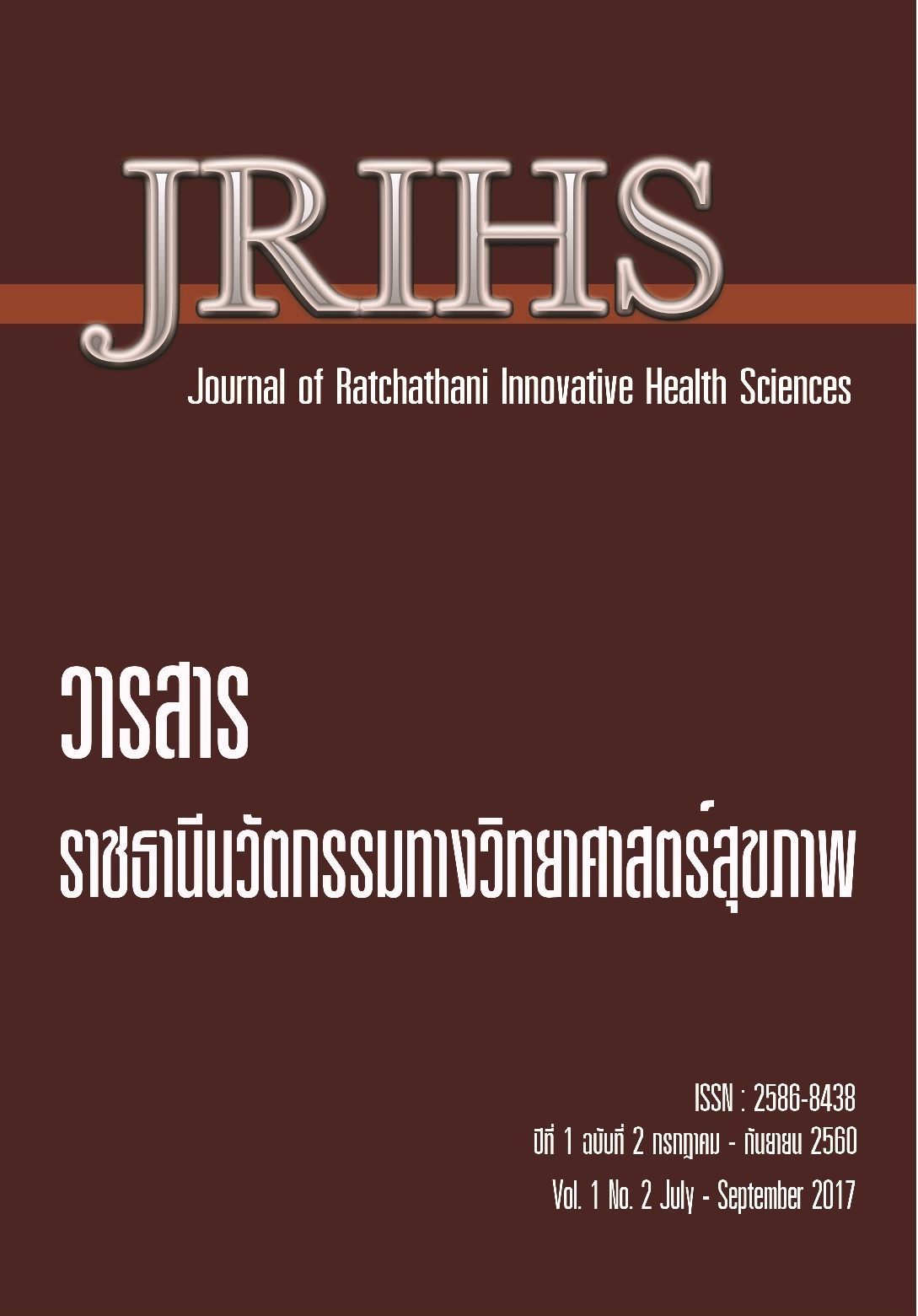ประสิทธิผลของการจัดการความปวดโดยใช้นวัตกรรม VNBN pain expression กับการจัดการความปวดแบบเดิม ในหอผู้ป่วยศัลยกรรมหญิง โรงพยาบาลนครพนม
Main Article Content
บทคัดย่อ
การวิจัยครั้งนี้เป็นการวิจัยกึ่งทดลอง (quasi-experimental research) มีวัตถุประสงค์เพื่อเปรียบเทียบประสิทธิผลของการจัดการความปวดโดยใช้นวัตกรรม VNBN pain expression กับการจัดการความปวดแบบเดิม ในหอผู้ป่วยศัลยกรรมหญิง โรงพยาบาลนครพนม กลุ่มตัวอย่างเป็นผู้ป่วยหลังผ่าตัดบริเวณหน้าท้อง หอผู้ป่วยศัลยกรรมหญิง ณ โรงพยาบาลนครพนม จำนวน 20 ราย แบ่งเป็น 2 กลุ่ม คือกลุ่มทดลองและกลุ่มควบคุม เก็บรวบรวมข้อมูลโดยใช้แบบบันทึกที่ผ่านการตรวจสอบความตรงตามเนื้อหา โดยผู้ทรงคุณวุฒิจำนวน 3 ท่าน และผ่านการพิจารณาจริยธรรมการวิจัยของวิทยาลัยพยาบาลบรมราชชนนีนครพนม วิเคราะห์ข้อมูลที่รวบรวมได้โดยใช้โปรแกรมสำเร็จรูปเพื่อทดสอบ โดยใช้สถิตินอนพารามิเตอร์ (non-parametric statistics) คือ Rank-sum Test (หรือ Wilcoxon-Mann Whitney-U Test) โดยกำหนดระดับนัยสำคัญที่ระดับ .05 ผลการวิจัย พบว่า มีค่าเฉลี่ยของระดับความปวดหลังผ่าตัดที่ 2 ชั่วโมง แตกต่างกันอย่างมีนัยสำคัญทางสถิติ (p=0.047) โดยกลุ่มทดลองเท่ากับ 6.4 คะแนน อยู่ในระดับปวดปานกลาง กลุ่มควบคุมเท่ากับ 7.7 คะแนน อยู่ในระดับปวดมาก และค่าเฉลี่ยของระดับความปวดหลังผ่าตัด 48 ชั่วโมง แตกต่างกันอย่างมีนัยสำคัญทางสถิติ (p=0.018) โดยกลุ่มทดลองเท่ากับ 2.2 คะแนน อยู่ในระดับปวดน้อย กลุ่มควบคุมเท่ากับ 3.6 คะแนน จากผลการศึกษานวัตกรรมประเมินความปวด VNBN pain expression มีประสิทธิผลมากกว่าการประเมินความปวดแบบเดิมอย่างมีนัยสำคัญทางสถิติที่ระดับ .05
Article Details
ความคิดเห็นและข้อเสนอแนะใดๆ ที่นำเสนอในบทความเป็นของผู้เขียนแต่เพียงผู้เดียว โดยบรรณาธิการ กองบรรณาธิการ และคณะกรรมการวารสารราชธานีนวัตกรรมทางวิทยาศาสตร์สุขภาพไม่ได้มีส่วนเกี่ยวข้องแต่อย่างใด มหาวิทยาลัยราชธานี บรรณาธิการ และกองบรรณาธิการจะไม่รับผิดชอบต่อข้อผิดพลาดหรือผลที่เกิดขึ้น จากการใช้ข้อมูลที่ปรากฏในวารสารฉบับนี้
เอกสารอ้างอิง
นิตยา ธีรวิโรจน์, อมรรัตน์ คงนุรัตน์, ทรงพร กว้างนอก, สุจิตรา สุขผดุง, ภูวดล กิตติวัฒนาสาร . (2554). การศึกษาสถานการณ์การประเมินความปวดในผู้ป่วยหลังผ่าตัดทางออร์โธปิดิกส์ โรงพยาบาลบุรีรัมย์(Postoperative Pain Assessment Situation in Orthopaedic Patients, Buriram Hospital). Journal of Nursing and Health Care, 29(4), 33–39.
มนัสนันท์ ศิริสกุลเวโรจน์. (2552). ประสิทธิผลของการใช้แนวทางเวชปฏิบัติการระงับปวดหลังผ่าตัดต่อการบรรเทาความปวดในผู้ป่วยที่ได้รับยาระงับความรู้สึกแบบทั่วไปในสถาบันบำราศนราดูร, วารสารวิจัยทางวิทยาศาสตร์สุขภาพ, 3(2), 22-31.
สมพร กันทรดุษฎี เตรียมชัยศรี. (2556). ภาควิชาการพยาบาลสาธารณสุข คณะสาธารณสุขศาสตร มหาวิทยาลัยมหิดล.
สิริญญา สิมะลี .(2557). ความคาดหวังกับประสบการณ์จริงเกี่ยวกับระดับความปวดหลังผ่าตัดและกิจกรรมพยาบาลที่บรรเทาความปวดหลังผ่าตัดของผู้ป่วยที่ได้รับการผ่าตัดใหญ่. วารสารโรงพยาบาลนครพนม, 1(1), 5-15.
อัจฉรียา ปทุมวัน. (2551). Pain assessment in pediatric patients. เอกสารประกอบการอบรม Pain update 2008. กรุงเทพฯ: ภาควิชาพยาบาลศาสตร์ คณะแพทยศาสตร์โรงพยาบาลรามาธิบดี.
Frampton, C. L., & Hughes-Webb, P. (2011). The measurement of pain. ClinicalOncology, 23, 381-386.
Horgas, A., & Yoon, S. L. (2008). Pain management. InE. Capezuti, D. Zwicker, M. Mezy & T. Flumer (Eds.), Evidence - based geriatic nursing protocols for best practice. New York: Springer, 199-22211.
Lorenz, H.P. & Longaker, M.T. (2001). Wounds: biology, pathology and management. In: Norton, J.A. et al. (editors), Surgery: basic science and clinical evidence. New York: Springer, 221-239.
Melzack Ronald. (2004). Gate Control Theory of Pain. Encyclopedia of Health and
Behavior.
Spadoni, G. F., Stratford, P.W., Solomon, P.E., Wishart, L.R. (2004). The evaluation of change in pain intensity: A comparison of the P4 and single item numeric pain rating scales. Journal of Orthopedic & Sports Physical Therapy, 34, 187-193.


